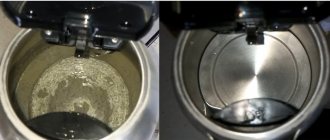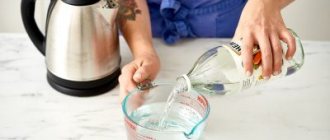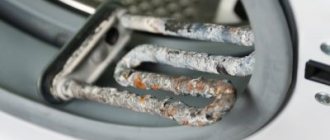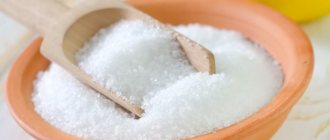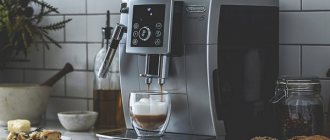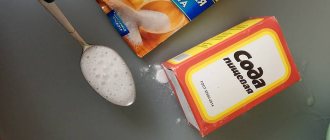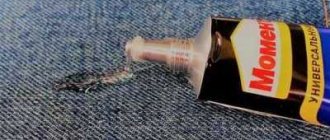Scale forms in any kettle - electric and regular. It accumulates on the walls in a thick layer, which is why the device copes worse with its main function.
Water from such a container cannot be considered clean. You can cope with the problem using inexpensive improvised means.
Read the article about how to remove scale from a kettle using citric acid using folk recipes, and how to remove lime deposits using household chemicals.
Can it be cleaned?
You can clean the kettle with citric acid. The layer that forms inside is salt deposits. They no longer dissolve in ordinary water. To destroy their hard shell, exposure to more aggressive substances is necessary.
Citric acid is the most accessible, safe and inexpensive remedy that helps to quickly cope with the problem. You can clean the kettle with lemon. It does not harm its walls, does not cause them corrosion or oxidation.
The preservative works exclusively on the surface, dissolving solid deposits. In the future, you can use such a device without danger to your health.
Assistant to the modern woman
An automatic washing machine is an expensive pleasure; take the trouble to take care of it, otherwise it may quickly break down. Guess the reason behind it - the reasons are legion, starting with hard water and ending with voltage surges.
Try using advertised water softeners; softeners are not cheap. Efficiency needs to be proven; in fact, the chemicals turn out to be absolutely useless, and you don’t want to disassemble the machine to see the result “obviously”.
Such softening chemicals do not rinse completely out of clothing; Allergy sufferers and people with sensitive skin can suffer. You can do preventive maintenance using softeners monthly; this measure is powerless against hard water. Stop getting upset and thinking that your delicate machine won’t last long to work: a proven, effective, affordable way to “treat” automatic machines against scale and salt deposits has been found: cleaning the washing machine with citric acid. Food. Citric acid crystals effectively clean scale, corroding the disordered structure of the build-up. Let's talk in more detail about an effective way to combat the consequences that threaten your machine caused by hard water.
How to remove lime deposits at home?
If the plaque is very dense and firmly fixed on the surface, you can deal with it in the following way:
Drain the kettle. Rinse it with warm water, you can walk over the surface with a sponge.- Fill the device with water. It should completely cover those areas where salt deposits are visible.
- Add citric acid. For each liter you will need 20 g of powder.
- Place the device on the stove or plug it into the network. Wait until it boils. If the kettle is electric, then when it turns off, you need to wait 10 minutes and turn it on again. Boil water in a regular kettle for 5 minutes.
- Leave the solution inside to work.
- Drain the water and remove the remaining sediment with the hard side of the sponge.
- If the plaque has not been completely removed, the procedure must be repeated.
- To remove any remaining product, you need to pour clean water into the kettle, boil it and drain it. After this, you can use the device as usual.
If the scale layer is small, then you can do without boiling. Features of the procedure:
- fill the kettle with clean warm water;
- add citric acid - 10 g of powder is required for 1 liter of water;
- leave the kettle to soak for at least 5 hours; if possible, leave the citric acid solution in the container overnight;
- pour out the water, rinse the device by going over it from the inside with a sponge.
This procedure will help you cope with plaque if it is barely noticeable.
The video will show you how to descale a kettle with citric acid:
What to add to enhance the effect?
To enhance the effect, the following substances are used together with citric acid:
Salt. For every 10 liters of water you will need 10 g of salt.- Soda. For a 3 liter kettle you will need 30 g of citric acid and 3 tablespoons of soda. Add them together, then heat the water without bringing it to a boil. It will take about an hour for the scale to completely dissolve.
- Vinegar. If the layer of limescale is thick, you can add 3 tablespoons of 9% vinegar to the citric acid solution. These substances mutually enhance each other's effects. The solution is boiled, left to act for an hour and drained.
Scale prevention
The following actions can help minimize the risk of scale formation:
- Rinse the kettle daily with running water, using a soft sponge to remove any plaque that has accumulated during the day;
- after boiling water, do not leave the liquid in the device’s reservoir for a long time, pour it into another container;
- remove scale as soon as it begins to form, and not when it has formed a thick layer of deposits on the walls.
Scale damages not only the electric kettle. Find out how to remove lime deposits from your washing machine. This publication will tell you about descaling your Philips iron.
REFERENCE! The service life of an electric kettle depends on the frequency of use of the device and the degree of care for it.
Not only the internal areas and elements of the device need to be cleaned, but also the external surfaces: periodically wipe the body with a damp sponge dipped in clean water or soapy water, and your tea drinking will always be tasty and enjoyable.
How often should I clean?
The kettle needs to be cleaned regularly. If you carry out the procedure at least once a month, scale will not form. The cleaning time depends on the quality of the tap water.
If it is soft, then scale forms slowly. In this case, treatment can be carried out once every 1.5-2 months. If the water is hard, limescale deposits quickly. Therefore, preventive cleaning of the device is carried out once every 3-4 weeks.
Citric acid does not harm the kettle even with frequent contact with its walls.
Alternative remedies
Citric acid is not the only means to combat scale. You can cope with it with the help of other substances that can be found in every home. Another option is to purchase a special detergent composition in the store.
The best folk recipes (with proportions)
The following substances effectively remove lime deposits in a kettle:
Sprite. This carbonated drink helps to quickly deal with plaque, without harm to the device itself.
The drink is poured into a kettle and left open for 20 minutes to allow the gas to escape, after which the liquid is brought to a boil and poured into the sink. It is not recommended to use Coca-Cola or Fanta, as they can stain the plastic kettle.- Soda and vinegar . They are used in turn. First, the kettle is boiled with a soda solution (20 g per 1 l). After which it is drained and vinegar solution is poured in (5 tablespoons per 5 liters of water). This recipe helps to cope with even the most stubborn scale.
- Oxalic acid . It is poured into the device at the rate of 10 g per 2 liters of water. The solution is brought to a boil, allowed to cool, and then poured into the sink.
How to clean using household chemicals?
You can deal with plaque using specialized household chemicals. The most effective formulations include:
- Topper for descaling a kettle. Pour 1 liter of water into the kettle and add 100-120 ml of cleaning product. Heat the water to 50 degrees and leave for half an hour. The solution is poured, rinsed thoroughly and the container is boiled. Cost 250 ml – 145 rubles.
- Mellerud. Dilute 60 ml of cleaning product in 250 ml of water, pour into a kettle, bring to a boil and turn off. After 15 minutes, the liquid is drained. The cost of 500 ml of solution is 270 rubles.
- Cinderella "Antinakipin" . Pour 2 liters of water into the kettle, pour the contents of 1 sachet into it and boil for 30 minutes. Then leave the product to act for 3 hours, drain the composition, and wash the dishes themselves with clean water. The cost of a 100 g bag of powder is 30 rubles.
Benefits of Citric Acid
The list of available means for descaling is large and includes, in addition to lemon juice, vinegar, soda, and carbonated water. But many people prefer this particular powder, for which there is good reason.
The product is the result of a chemical reaction and looks like a crystalline powder. The taste is sour. AHA acid (that’s exactly what its name sounds like in chemistry) is a 3-basic carbonic acid, found naturally in fruits (mostly in citrus fruits).
There is about 6 g in lemon, 7 g in lime, and a little more than one gram in black currant (content per 100 g of product).
But contrary to popular belief, acid is not produced from lemons. It is obtained through the process of biosynthesis from sugar-containing raw materials (hydrolysates of corn, sweet potato, cassava). “Limonka” is odorless, colorless, and dissolves well in water.
In the food industry it is used as a flavoring additive (designation E 330).
One of the reasons for the popularity of the powder as a means for descaling at home is the absence of a specific odor and harmlessness. Unlike a solution with vinegar, which cannot be worked with without taking certain precautions, “lemon” is simple and easy to use.
The benefits also include:
- efficiency. Removes plaque well and quickly, even old scale;
- availability of the product (sold in any supermarket);
- cheapness. Sachets from 5 to 100 g, cost varies from 10 to 50 rubles;
- organic composition;
- A small amount is required to prepare the cleaning solution;
- Suitable for cleaning kettles, thermopots, dishwashers.
It is believed that the product can be used for dishes made of any material (glass, enamel, stainless steel, plastic). Although many housewives note that glass and plastic models must be cleaned carefully, using not too concentrated solutions and excluding boiling.
We can also use the powder for electric kettles, but only if the heating elements are made of high-quality stainless steel. She doesn’t care about an acid solution, but heating elements of cheap models made of “left-handed” alloys often become deformed and become unusable. So, when cleaning devices operating from the network, they act with acid very carefully and correctly, following the instructions.
Features for different surfaces
Different materials react differently to cleaning. In order not to spoil the dishes, you need to consider the following points:
glass - it is not afraid of contact with citric acid, but it cannot be rubbed with a wire brush, as small scratches will appear on the surface;- plastic - the device reacts normally to treatment with lemon juice, but aggressive acids should not be used to clean it;
- metal - the material is resistant to citric acid, it can be rubbed with soft brushes, but you should not try to remove scale with a knife or other sharp object.
Tips and tricks
To keep the washing machine in good condition, it is enough to clean it every six months with citric acid or another product. For regions with hard water, more frequent cleaning is recommended.
- After a long break in using the machine, you should carry out a cleaning cycle and only then begin normal use.
- Before leaving for a long period of time, the machine should be wiped dry.
- If clothes are washed using powders and conditioners with increased foaming, it is necessary to carry out an additional rinse to ensure that all undissolved particles are removed.
- You should not add citric acid to the powder during normal washing. The result will be poorly washed items and ineffective cleaning.
Any skincare procedures are effective only with regular use. This statement also applies to cleaning the washing machine using any chosen method. And then you don’t have to worry about sudden breakdowns or poor removal of dirt.
https://youtube.com/watch?v=YpGvGK1HhnU
Helpful information
To ensure that the procedure for removing lime deposits is effective and safe for health, you need to follow simple rules:
- You should not drink water from the kettle immediately after the procedure. First you need to boil it with clean water and drain it. Only after this can the device be fully used.
- All household members should be warned that the kettle is filled with descaling liquid. This will avoid poisoning.
- Once the cleaning solution boils, do not immediately pour it into the sink. The longer it stays inside, the higher the cleaning efficiency.
You can learn about methods and methods for descaling here.

